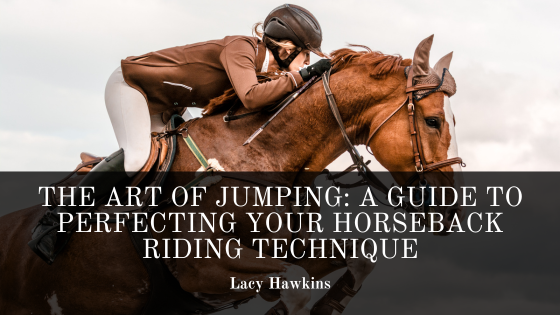Jumping is a thrilling and exciting aspect of horseback riding that requires skill, precision, and a deep understanding of both horse and rider. Whether you are just starting out or looking to improve your technique, there are a few key principles to keep in mind when it comes to the art of jumping.
The first and perhaps most important principle is balance. Jumping requires a rider to maintain their balance and stability throughout the entire process, from approaching the jump to landing on the other side. This means keeping a centered and balanced position in the saddle, with the weight evenly distributed between both stirrups and the seat bones. It also means keeping a light and supple grip on the reins, allowing the horse to move freely while still maintaining control.
The second principle of jumping is rhythm. A smooth and consistent rhythm is essential for a successful jump, as it allows the horse to approach the jump with confidence and energy. This means maintaining a consistent pace and stride length, as well as using proper leg and rein aids to encourage the horse to maintain its rhythm and balance.
The third principle of jumping is technique. Proper technique is essential for a successful jump, as it allows the horse to clear the obstacle safely and efficiently. This means using the correct position and aids to guide the horse over the jump, as well as to maintain a clear and consistent line of approach. It also means using proper timing and release with the reins, allowing the horse to stretch their neck and use their head and neck to clear the jump.
The fourth principle of jumping is confidence. Jumping can be a daunting and intimidating experience for both horse and rider, but confidence is key to success. This means approaching each jump with a positive and focused mindset, as well as trusting in the horse’s abilities and instincts. It also means being willing to take risks and try new things without becoming overly cautious or hesitant.
Finally, the fifth principle of jumping is practice. Like any skill, jumping requires practice and repetition in order to improve. This means setting up a consistent training routine that includes both flatwork and jumping exercises, as well as seeking out opportunities to practice in different settings and with different obstacles. It also means being patient and persistent, as progress may be slow at first but will eventually lead to improvement and success.
In addition to these principles, there are also a few common mistakes and pitfalls to avoid when it comes to jumping. These include leaning too far forward or back in the saddle, using too much or too little leg or rein aids, and failing to maintain a consistent pace and rhythm. It is also important to avoid over-jumping or overworking the horse, as this can lead to fatigue, injury, and decreased performance.
The art of jumping is a complex and challenging aspect of horseback riding that requires skill, precision, and a deep understanding of both horse and rider. By focusing on principles such as balance, rhythm, technique, confidence, and practice, riders can work on perfecting their jumping technique and achieving success in this exciting and rewarding discipline. Whether you are a seasoned equestrian or just starting out on your horseback riding journey, take the time to develop your jumping skills and enjoy the thrill of this unique and exciting sport.
